-

2022年江苏省宿迁市中考英语真题 (解析版)
ThreeRiver-Source National Park on the Qinghai-TibetPlateau(青藏高原),is the largest national park in China. Because it is home to the sources of theYangtze, Yellow and Lancang rivers, people call it “China’s water tower”.
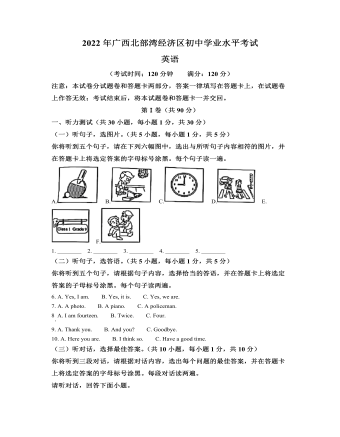
2022年广西北部湾经济区中考英语真题(解析版)
Ibelieved that I was right and he was wrong, and Tony believed that I was wrongand he was right. Our teacher, a kind and smart lady, decided to teach us alesson. She brought us to the front of the class and placed him on one side ofher desk and me on the other. In the middle of her desk was a large and roundobject. I could clearly see that it was black. The teacher asked us what colorthe object was. “White,” Tony answered. I couldn’t believe he said the objectwas white! “Clearly, it was black!” Another argument started between Tony andme, this time about the color of the object.
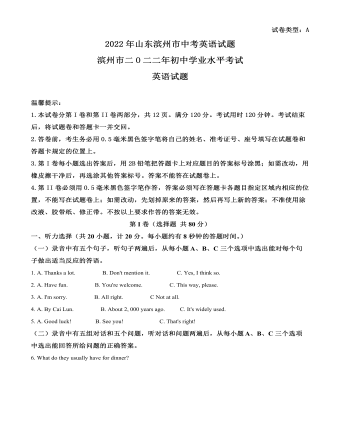
2022年山东省滨州市中考英语真题(解析版)
Everyone knows how similar chimpanzees (黑猩猩)are to humans. So it’s no surprise that their greetings are also close to ours.The most common ways of greeting between chimpanzees are hand touching andhugging. Sometimes they also kiss each other. Some chimpanzees can even learnsimple sign language.
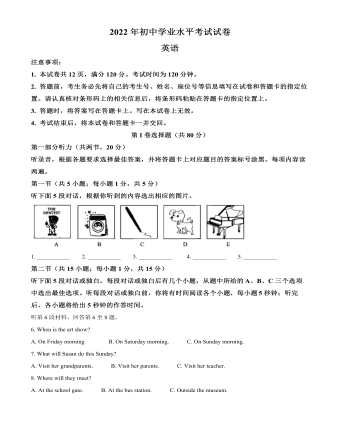
2022年内蒙古包头市中考英语真题(解析版)
Mostschools offer different kinds of subjects and activities for students, but someschools offer additional training in certain areas, such as the performing andarts. In this way, schools can help students develop their artistic talentsfrom an early age and have greater success in their future profession. THE ROYAL BALLET(芭蕾舞)SCHOOL
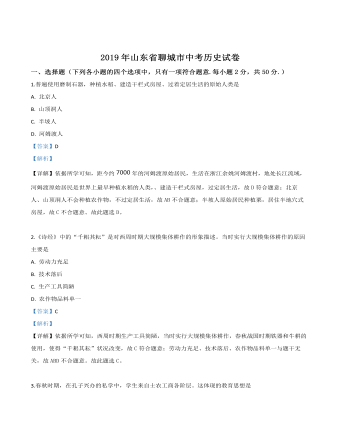
山东省聊城市2019年中考历史试题(解析版)
31.阅读下列材料,回答问题。材料一 农,天下之大本也,民所恃以生也。而民或不务本而事末,故生不遂。——汉文帝材料二 世儒不察,以工商为末。妄议抑之。夫工商圣王之所欲来,商又使其愿出于途者,盖皆本也。——黄宗羲(1)材料一反映了中国古代哪一重要思想?据此,西汉统治者采取了哪些措施?(2)材料二中黄宗羲提出了什么主张?应如何评价这一主张?
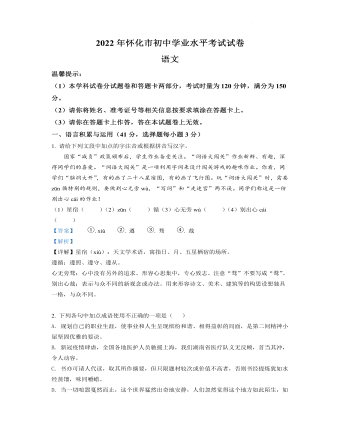
2022年湖南省怀化市中考语文真题(解析版)
【海外网2月21日电】2月20日,北京冬奥会正式闭幕,这届冬奥会为世界留下了独具特色的中国记忆,收获了众多好评,各国运动员持续发文为北京冬奥会点赞。“感谢、祝福”成了高频词。
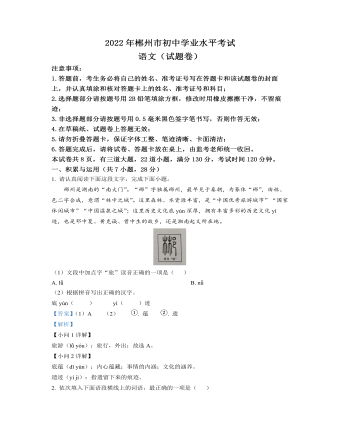
2022年湖南省郴州市中考语文真题(解析版)
余幼时即嗜学。家贫,无从致书以观,每假借于藏书之家,手自笔录,计日以还。天大寒,砚冰坚,手指不可屈伸,弗之怠。录毕,走送之,不敢稍逾约。以是人多以书假余,余因得遍观群书。
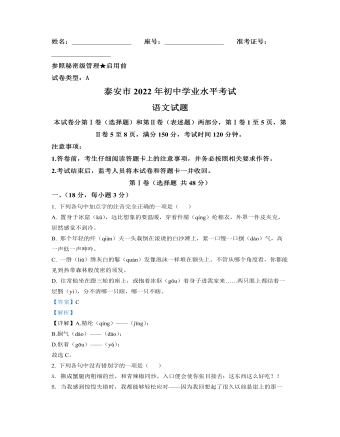
2022年山东省泰安市中考语文真题(解析版)
小住京华,早又是中秋佳节。为篱下黄花开遍,秋容如拭。四面歌残终破楚,八年风味徒思浙。苦将侬强派作蛾眉,殊未屑!身不得,男儿列,心却比,男儿烈。算平生肝胆,因人常热。俗子胸襟谁识我?英雄末路当磨折。莽红尘何处觅知音?青衫湿!
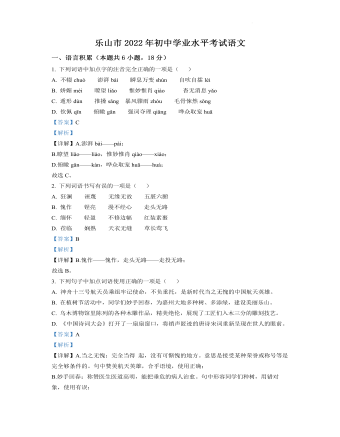
2022年四川省乐山市中考语文真题(解析版)
阅读下面这首宋诗,完成下面小题。插秧歌杨万里田夫抛秧田妇接,小儿拔秧大儿插。笠是兜鍪①蓑是甲,雨从头上湿到胛②。唤渠③朝餐歇半霎,低头折腰只不答:“秧根未牢莳未匝④,照管鹅儿与雏鸭。”【注】①兜鉴:古代战士戴的头盔。②胛:肩胛。③渠:他。④莳未匝:插秧没有完成。
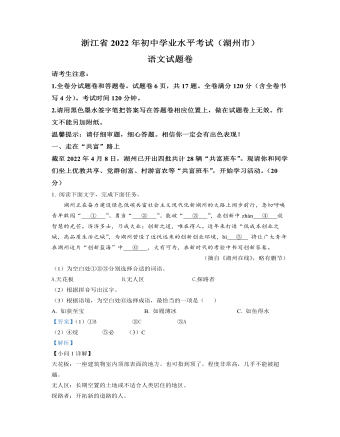
2022年浙江省湖州市中考语文真题(解析版)
地瓜没进过城,没见过世面,没受过励志教育。除了憨,它没别的见识和想法。被我那也没见过世面的爹爹埋没在土里。埋没了就埋没了。土里暖和,土里有营养。果然,这没见过世面的傻子,却长成了敦实汉子,地道的瓜。一排排黄瓜手扶着藤蔓做引体向上体操。
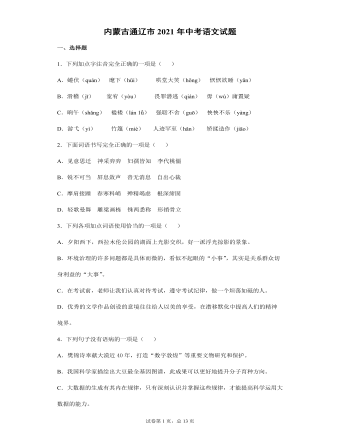
2021年内蒙古通辽市中考语文真题(解析版)
妈妈19岁嫁给爸爸。外婆生育了6个孩子,还领养了一个,但妈妈是唯一的女儿,在那个年代,虽然说不上能享受到多少宠爱,但至少没有遭受过任何对女性的轻慢,妈妈甚至还念到初中毕业,字写得比我还好,能自由阅读文学作品。
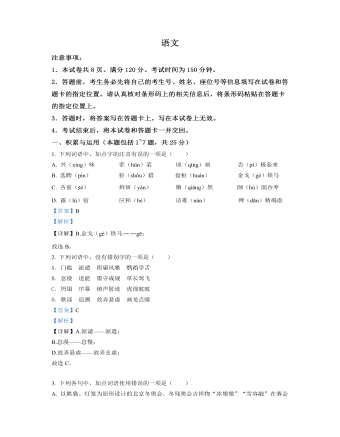
2022年内蒙古包头市中考语文真题(解析版)
夜来似闻某人素心,明日试往看之,入其门,窥其闺,见所谓某人方据案面南看一文书。顾客入来,默然一揖,便拉袖命坐,曰:“君既来,可亦试看此书。”相与欢笑。日影尽去,既已自饥,徐问客曰:“君亦饥耶?”不亦快哉!
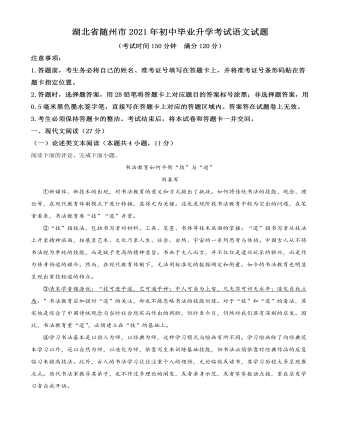
湖北省随州市2021年中考语文试题(解析版)
位朋友在从莫斯科通往彼得堡的尼古拉铁路的一个站点上邂逅。两个人中一位是胖子,一位是瘦子。胖子刚在站点的餐厅用过午餐,嘴唇油光锃亮,活像两颗熟透了的樱桃。他身上散发出一股烈性葡萄酒和橙花的气息。瘦子呢,刚从车厢里出来,费劲地拖着提箱、大包小包和几只纸板盒子。他的身上则有一股火腿肠和咖啡渣的气息。他的身后,有个尖下巴的瘦女人在东张西望,那是他的妻子,此外还有他的儿子,一位高个子的中学生,眯着一只眼睛。
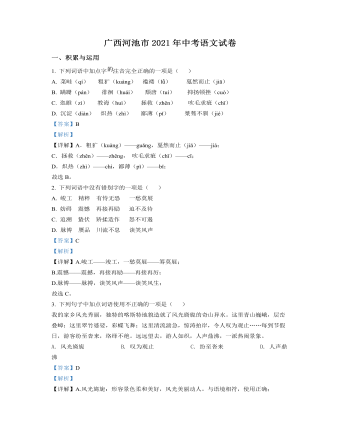
广西河池市2021年中考语文试题(解析版)
什么是精进?“精”,精者无杂,是集中精力、全力以赴做好一件事情。是对学习,对工作,对事业精益求精、专注投入的精神状态。“进”,是一种“锲而不舍”的钻劲,是为达到目标不懈付出努力的进取行为。“精进”也是勤勉、奋斗,不懈怠、不偷懒的代名词。
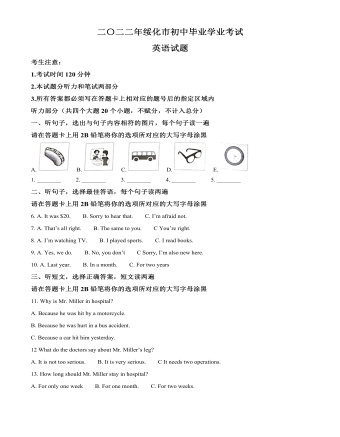
2022年黑龙江省绥化市中考英语真题(解析版)
There are many kinds ___21___art forms in China. ___22___ you often see any of them in your life?They help us understand and enjoy the traditional Chinese culture. When theSpring Festival comes, some people often ___23___ the red paper intodifferent art works with scissors.
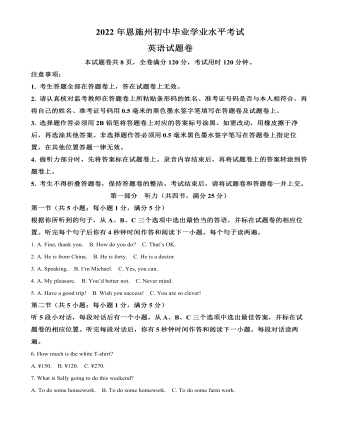
2022年湖北省恩施州中考英语真题(解析版)
Once, herfather took her to the kitchen. He asked Jane to take a potato, an egg ____11____ two spoons of tea leaves. Jane was ____12____, andasked her father, “Do you want me to cook?”
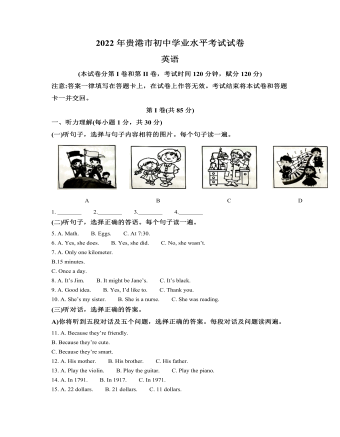
2022年广西贵港市中考英语真题(解析版)
TheChinese knot, a folk art, has a long history. People first made them to recordinformation and send messages before they started to use words. The knots wereused for decoration (装饰) and to express thoughts and feelings in theTang Dynasty. They were later popular in the Ming and Qing dynasties. But thisart wasn’t really accepted by the common people until the Qing Dynasty.

2022年江苏省无锡市中考英语真题(解析版)
Jared ___15___ to stay at home, but his mom sent him anyway.He had to sit next to Jessica. At reading time, Mrs. Thomas asked Jared toread. Reading aloud always made Jared ___16___ . As he picked up the book, his hands shook.“He can’t read,” Jessica said. “I didn’t call on you, did I?”
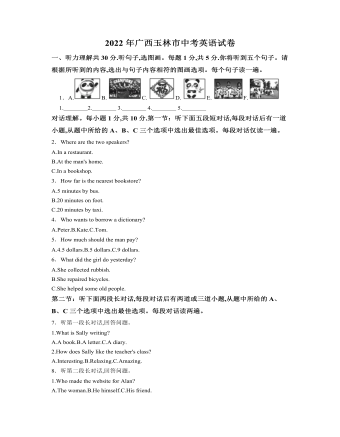
2022年广西玉林市中考英语真题(解析版)
Antarctica is a continent (大陆) of ice. There is hardlyany rain in Antarctica, so the Antarctic Desert becomes the driest desert inthe world. It is also the world’s largest desert by area.
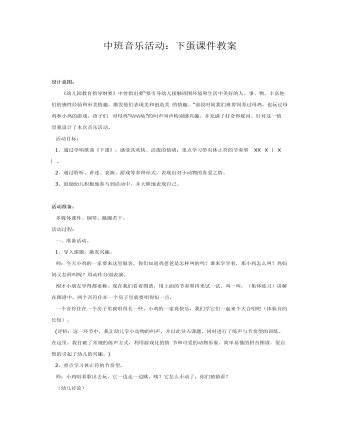
中班音乐活动:下蛋课件教案
活动目标: 1、通过学唱歌曲《下蛋》,感受其欢快、活泼的情绪;重点学习带有休止符的节奏型 XX X ︳X ︳。 2、通过聆听、讲述、表演、游戏等多种形式,表现出对小动物的喜爱之情。 3、鼓励幼儿积极地参与到活动中,并大胆地表现自己。 活动准备: 多媒体课件、钢琴、跳圈若干。活动过程: 一、准备活动。 1、导入课题,激发兴趣。 师:今天小鸡的一家要来这里做客,你们知道鸡爸爸是怎样叫的吗?谁来学学看,那小鸡怎么叫?鸡妈妈又怎样叫呢?用动作分别表演。 刚才小朋友学得都很棒,现在我们看着图谱,用上面的节奏型再来试一试、叫一叫,(集体练习)讲解在图谱中,两个音符住在一个房子里就要唱得短一点, 一个音符住在一个房子里就唱得长一些。小鸡的一家真快乐,我们学它们一起来个大合唱吧(体验音的长短)。 (评析:这一环节中,我让幼儿学小动物的叫声,并以此导入课题,同时进行了练声与节奏型的训练。在这里,我打破了常规的练声方式,利用游戏化的情节和可爱的动物形象、简单易懂的拼音图谱,很自然的引起了幼儿的兴趣。) 2、重点学习休止符的节奏型。 师:小鸡唱着歌出去玩,它一边走一边跳,咦?它怎么不动了,你们猜猜看? (幼儿讨论) 原来它遇到了一个大陷阱。那么,在这里我们就要停一下,也就是停一拍。我们一起来试试看,做动作, JiJi Ji ︳Ji 停 |,那停的时候我们用一个什么动作来表示呢? 3、引入歌曲中的难点句。 “我们一起用刚才学过的本领,来学打这一句的节奏。” (评析:休止符的掌握是本次活动的难点,我利用情境启发的教学方法由休止符联想到陷阱或障碍,需要停一拍,从而帮助幼儿更好地理解记忆节奏型, 同时也为下面的活动打下基础。)

